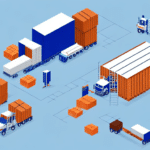What Is Cross Docking? Exploring the Benefits and Challenges of This Logistics Method
Cross docking is a logistics method that involves the transfer of goods from incoming trucks or trailers to outgoing vehicles with minimal or no time spent in storage or handling. In this article, we delve into the fundamentals of cross docking, its historical evolution, advantages, disadvantages, implementation strategies, types, key performance indicators (KPIs), best practices, technological advancements, real-world case studies, challenges, limitations, future trends, and a concluding assessment.
Understanding the Basics of Cross Docking and How It Works
Unlike traditional warehousing, cross docking prioritizes speed and efficiency. The primary goals are to reduce inventory and handling costs, shorten transit times, and enhance product quality and customer satisfaction. Cross docking facilities serve as intermediaries between suppliers and customers by receiving inbound shipments, sorting them, and promptly dispatching them to their respective destinations. Successful cross docking relies on a well-organized schedule, skilled labor, appropriate equipment, and real-time information systems.
According to a 2023 Supply Chain Report, businesses implementing cross docking have seen a 15% reduction in lead times and a 20% increase in order accuracy.
The History of Cross Docking and Its Evolution Over Time
The concept of cross docking originated in the 1930s, initially utilized for transporting agricultural products. Its popularity surged in the 1970s and 1980s with the advent of electronic data interchange (EDI) and just-in-time (JIT) production methodologies. Today, cross docking is integral to various industries, including food, retail, pharmaceuticals, and automotive, offering significant reductions in waste, improved responsiveness, and enhanced supply chain agility.
Recent advancements have integrated automation and AI, further optimizing cross docking operations and expanding its applicability across more complex supply chains.
Advantages and Disadvantages of Cross Docking for Your Business
Cross docking offers numerous benefits:
- Faster Delivery Times: Accelerates the movement of goods from suppliers to customers.
- Reduced Inventory Costs: Minimizes the need for extensive warehousing.
- Improved Quality Control: Enhances product handling efficiency.
- Better Utilization of Space: Optimizes facility layout and storage.
- Enhanced Supply Chain Visibility: Provides real-time tracking and monitoring.
However, there are potential drawbacks:
- Higher Transportation Costs: Increased reliance on frequent, smaller shipments.
- Lower Flexibility: Requires consistent and predictable shipment schedules.
- Increased Dependence on Suppliers and Carriers: Necessitates reliable and timely partners.
- Potential for Errors and Delays: High speed can sometimes compromise accuracy.
To determine if cross docking suits your business, assess product characteristics, demand patterns, operational capabilities, and customer requirements.
How to Implement Cross Docking in Your Supply Chain Management
Implementing cross docking involves several strategic steps:
- Identify Suitable Products: Evaluate demand patterns, handling needs, and packaging requirements.
- Select the Right Location: Consider proximity to suppliers and customers, transportation access, and zoning regulations.
- Design Facility Layout: Optimize inbound and outbound docks, staging areas, sorting zones, and traffic flow.
- Choose Appropriate Equipment: Invest in forklifts, pallet jacks, conveyor systems, and dock levelers.
- Hire and Train Personnel: Ensure staff are skilled in scheduling, inventory tracking, quality control, and safety.
- Integrate Technology Systems: Utilize RFID, GPS, barcode scanning, and advanced software for inventory and transportation management.
Proper planning and execution are crucial for a seamless transition to cross docking operations.
Cross Docking vs. Traditional Warehousing: A Comparison of Costs and Efficiency
When compared to traditional warehousing, cross docking offers significant cost and efficiency advantages:
- Cost Savings: Reduced need for storage space, lower labor costs, and minimized handling expenses.
- Efficiency Gains: Faster processing times, reduced transit periods, and increased operational flexibility.
- Risk Reduction: Lower chances of damage, spoilage, and theft due to decreased handling.
Conversely, traditional warehousing may incur higher costs and longer lead times but offers greater customization, nuanced quality control, and risk mitigation capabilities.
Common Types of Cross Docking Operations and Their Applications
Cross docking operations can be categorized based on processing levels and customization needs:
- Pure Cross Docking: Direct transfer from inbound to outbound vehicles without handling or processing. Ideal for high-demand, fast-moving products like perishable goods.
- Consolidation Cross Docking: Combining smaller shipments into larger ones to reduce transportation costs. Suitable for suppliers shipping small volumes to distribution centers.
- Deconsolidation Cross Docking: Splitting large shipments into smaller ones to meet specific customer or store requirements. Beneficial for retailers distributing to multiple locations.
- Hybrid Cross Docking: A mix of the above types to address complex supply chain needs. Effective for volatile or multifaceted supply chains.
Key Performance Indicators (KPIs) to Measure Success in Cross Docking Operations
Assessing the effectiveness of cross docking operations involves tracking several KPIs:
- Dock Utilization Rate: Percentage of time each dock is actively used for loading or unloading.
- Throughput Time: Duration from inbound receiving to outbound shipping.
- Fill Rate: Percentage of orders fulfilled completely without backorders or substitutions.
- Order Accuracy: Percentage of orders shipped without errors or damages.
- Inventory Accuracy: Percentage of inventory accurately counted and matched with system records.
Regular monitoring and analysis of these KPIs can drive continuous improvement in cross docking processes.
Best Practices for Successful Cross Docking Implementation and Management
To optimize cross docking operations, consider the following best practices:
- Develop a Strategic Plan: Align cross docking initiatives with overall supply chain goals.
- Choose Reliable Partners: Collaborate with experienced suppliers and carriers proficient in cross docking.
- Establish Clear Communication: Maintain transparent channels among suppliers, carriers, customers, and internal teams.
- Invest in Advanced Technologies: Implement real-time tracking, monitoring, and reporting tools.
- Continuous Performance Evaluation: Use KPIs and metrics to assess performance and drive improvements.
The Role of Technology in Streamlining Cross Docking Processes
Technology is pivotal in enhancing cross docking efficiency through:
- Radio-Frequency Identification (RFID): Enables accurate tracking and identification of products and assets.
- Global Positioning System (GPS): Facilitates real-time location tracking of vehicles and shipments.
- Automated Guided Vehicles (AGVs): Streamlines internal transportation of goods within facilities.
- Warehouse Management Systems (WMS): Optimizes warehouse and distribution center operations.
- Transportation Management Systems (TMS): Enhances carrier selection, route planning, and transportation optimization.
Integrating these technologies can lead to significant improvements in accuracy, speed, and overall operational efficiency.
Case Studies: Real-World Examples of Successful Cross Docking Implementations
Several organizations have effectively leveraged cross docking to enhance their logistics operations:
Wal-Mart
Wal-Mart, a global retail giant with over 11,000 stores in 27 countries, employs cross docking to minimize inventory costs and boost product availability. Their network of more than 150 distribution centers processes and sorts over 130 million cases of merchandise weekly. Utilizing RFID technology, Wal-Mart achieves unparalleled inventory tracking and management efficiency, contributing to their market leadership.
Toyota
To enhance supply chain efficiency, Toyota implemented a cross docking system at its North American parts center in Ontario, Canada. This initiative reduced lead times and transportation costs while improving inventory accuracy and quality control. Toyota increased parts delivery frequency from weekly to twice daily and decreased warehouse space requirements by 25%, thereby enhancing competitiveness and customer satisfaction.
H&M
H&M, a leading global fashion retailer, adopts cross docking to expedite its supply chain and minimize its carbon footprint. Their central warehouse in Germany receives supplier shipments and redistributes them to regional warehouses or stores through cross docking. This approach reduced transport emissions by 16% in 2019 and aligns with H&M's goal of achieving 100% renewable energy usage by 2030.
Challenges and Limitations of Cross-Docking in Today's Economy
Despite its advantages, cross docking faces several challenges:
- Capacity Constraints: Limited space and resources can hinder the handling of large or diverse shipments.
- Information Gaps: Real-time data sharing may be impeded by issues related to data quality, security, and system compatibility.
- Risk Exposure: Increased intermediaries and handoffs heighten the risk of disruptions, damages, and losses.
- Competitive Pressure: The commoditization of cross docking services can lead to pricing pressures and quality compromises.
Addressing these challenges requires strategic planning, robust technology integration, and strong partnerships.
Future Trends in the Use of Cross-Docking as a Logistics Method
Cross docking is poised to evolve with emerging trends shaping its future:
- Big Data Analytics: Leveraging data from cross docking operations to enhance decision-making and optimization.
- Artificial Intelligence (AI) and Machine Learning: Automating repetitive tasks, pattern recognition, and improving operational accuracy.
- Blockchain Technology: Enhancing transparency, traceability, and security in multi-party transactions.
- Zero-Emission Vehicles: Utilizing electric or hydrogen-powered vehicles and drones to reduce environmental impact.
These trends are expected to drive greater efficiency, sustainability, and adaptability in cross docking operations.
Conclusion: Is Cross-Docking the Right Choice for Your Business?
Cross docking presents a compelling logistics solution with numerous benefits and challenges applicable to businesses across various industries. Its effectiveness depends on factors such as product types, volume fluctuations, customer demands, supplier reliability, geographical locations, and operational capabilities. To determine the suitability of cross docking for your business, conduct a comprehensive evaluation of your current supply chain performance, establish clear goals, and assess the feasibility and risks associated with implementation. With a strategic approach, reliable partners, advanced technology, and adherence to best practices, cross docking can significantly enhance customer satisfaction, reduce costs, and bolster your competitive edge in today's dynamic and digital economy.




















